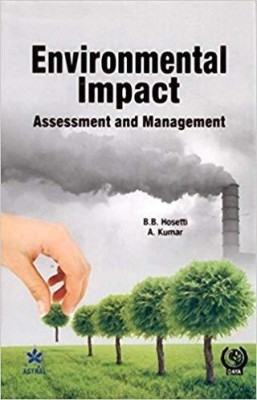Enviromental Impact Assessment and Management(English, Hardcover, Hosetti B. B.)
Quick Overview
Product Price Comparison
This book entitled Environmental Impact Assessment and Management, embodies 15 chapters covering a wide spectrum. Chapter 1 contains details of EIA, Basic elements and Methodologies. Further, important guidelines to be followed before establishing industries, water related projects and transport related projects are narrated in Chapter 2. Important case studies of EIA viz, second stage expansion of Malpe fishing harbour, Human impact on Himalayan Ecosystem, Konkan Railway Project, Heavy metal pollution in the Coovum river, an impact prediction for an irrigation project and impact of cement making on the air quality of Coimbatore, are dealt in Chapter 3. Once a project comes into existence, it results in side effects of the immediate environment which are evident on the consecutive 5-10 years of operation. Therefore, its efficiency and pollution abatement systems should be checked and corrected in a manner similar to financial auditing and this aspect has been incorporated in Chapter 4. Now-a-days due to the rapid process of urbanization, all the cities of India have accumulated a lot of filth leading to ghasty smell, loss of property value and the spread of diseases. In order to have a clean environment, we have to have a systematic refuse management package for Indian conditions. As illustrations of this view, the urban solid waste management in Hyderabad, Shimoga and Rourkee cities have been explained in the Chapter 5 and 6 respectively. The consecutive chapters deal on various other aspects such as coastal zone management, deforestation, impact of mining on fisheries, wild life management, termite pest control, bioremediation of wastes by hydrophytes, role of remote sensing in EIA, Kaiga environment and management of food protection.┬Ā Table of Contents Chapter 1: Environmental Impact Assessment: General Introduction, Basic Elements and Methods┬Ā Chapter 2: Guidelines for EIA of Industrial Establishments, Water Related Projects and Transport Related Activities┬Ā Chapter 3: Environmental Waste Auditing┬Ā Chapter 4: Case Studies on EIA: A case study on second stage expansion of a malpe fishing harbour, Human impact on himalayan ecosystem, Konkan railway project, Impact prediction of an irrigation project: A case study of upper tunga project (UTP) at shimoga, Impact on air quality due to cement making: A case study of the A C C Ltd, madhukkarai, coimbatore district, Heavy metal pollution in the cooum river flowing through madras city,┬Ā Chapter 5: Solid Waste Management in India: General Aspects┬Ā Chapter 6: Case Studies on USWM: Urban solid waste management with reference to hyderabad city, Urban solid waste assessment and management for shimoga city, Solid waste generation and its disposal in the steel plant, rourkela, orissa┬Ā Chapter 7: Coastal Zone Management with Special Reference to Karnataka┬Ā Chapter 8: Case Studies: Deforestation: A critical issue, Impact of human population growth on forests in and around bhadravati, Impact of coal mining effluents on fish farming and fish farmers: A case study of chitra coal mines, bihar, Response of some tree species to iron mine rejects: A case study┬Ā Chapter 9: Wild Life Conservation and Management in India┬Ā Chapter 10: Termite Infestation in the B R Project Area: A Case Study┬Ā Chapter 11: Use of Aquatic Plants as Biological Filters for Wastewater Treatment: An Overview┬Ā Chapter 12: Surface and Ground Water Budgets for the Dakshina Kannada District┬Ā Chapter 13: Application of Remote Sensing Techniques for EIA┬Ā Chapter 14: Baseline Background Radiations: A Primafacie Study as a Part of EIA for Kaiga Nuclear Power Plant┬Ā Chapter 15: Food Preservation by Ionizing Radiation and its Impact on Environmental Management.


